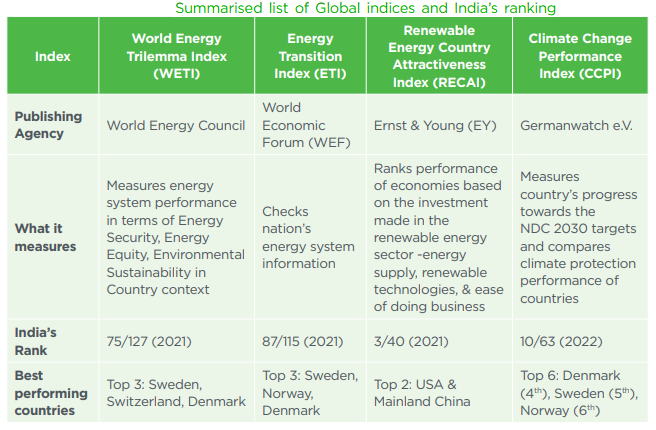Biodiversity & Environment
State Energy and Climate Index
- 12 Apr 2022
- 7 min read
For Prelims: Global climate indices and India’s Ranking, State Energy and Climate Index, NITI Aayog.
For Mains: India's Contribution Towards Net Zero Carbon Emission, Panchamrit advocacy of five elements for climate change at CoP-26, Conservation.
Why in News?
Recently, the NITI Aayog launched the State Energy and Climate Index (SECI). It is the first index that aims to track the efforts made by states and UTs in the climate and energy sector.
- The parameters of the index have been devised keeping in mind India’s goals for climate change and clean energy transition.
What are the Key Points of SECI?
- Objectives: The objectives of the index are:
- Ranking the States based on their efforts towards improving energy access, energy consumption, energy efficiency, and safeguarding the environment.
- Helping drive the agenda of the affordable, accessible, efficient and clean energy transition at the State level,
- Encouraging healthy competition among the states on different dimensions of energy and climate.
- Parameters: The State Energy and Climate Index (SECI) ranks states and UTs on six parameters:
- Discoms' (Power distribution companies) Performance,
- Access Affordability And Reliability Of Energy,
- Clean Energy Initiatives,
- Energy Efficiency,
- Environmental Sustainability,
- New Initiatives.
- Categorization: Based on the outcome of SECI scores, states and union territories have been categorised into three groups -- front runners, achievers, and aspirants.
- Top Performers: Gujarat, Kerala and Punjab have been adjudged as top three performer states in the NITI Aayog’s SECI.
- The top three performers among smaller states are Goa, Tripura and Manipur.
- Unsatisfactory Performance: States like Chhattisgarh, Madhya Pradesh and Jharkhand were placed at the bottom.
- Top Performers: Gujarat, Kerala and Punjab have been adjudged as top three performer states in the NITI Aayog’s SECI.
- Need: India is a resource-rich and diverse country. Many of its states are comparable to countries in the European Union in terms of area, population, and diversity of resources.
- Thus, a one-size-fits-all approach will not be appropriate as each state and Union Territory (UT) differ in terms of culture, geography, and use of energy resources.
- It is imperative for each state and UT to have its own policy to harness its potential and capability.
What are India’s Climate Change Commitments?
- The Prime Minister of India at the COP-26 Glasgow summit presented five nectar elements, Panchamrit, to deal with climate change:
- India will reach its non-fossil installed electricity capacity to 500 GW by 2030.
- India will meet 50% of its electricity requirements from renewable energy by 2030.
- India will reduce the total projected carbon emissions by one billion tonnes from now onwards till 2030.
- By 2030, India will reduce the carbon intensity of its economy by less than 45%.
- By the year 2070, India will achieve the target of Net-zero.
UPSC Civil Services Examination, Previous Year Questions (PYQs)
Q. Consider the following statements: (2016)
- The International Solar Alliance was launched at the United Nations Climate Change Conference in 2015.
- The Alliance includes all the member countries of the United Nations.
Which of the statements given above is/are correct?
(a) 1 only
(b) 2 only
(c) Both 1 and 2
(d) Neither 1 nor 2
Ans: (a)
- International Solar Alliance was launched at the United Nations Climate Change Conference in Paris in November 2015 by the Indian Prime Minister and French President. Hence, statement 1 is correct.
- At initial stage ISA was opened to membership of countries lying fully or partly between the Tropics of Cancer and Capricorn (torrid zone). In 2018, the membership of ISA was opened for all the UN members. However, all the member countries of the UN are not its members. Hence, statement 2 is not correct.
- Therefore, option (a) is the correct answer.
Q. With reference to the Agreement at the UNFCCC Meeting in Paris in 2015, which of the following statements is/are correct? (2016)
- The Agreement was signed by all the member countries of the UN and it will go into effect in 2017.
- The Agreement aims to limit the greenhouse gas emissions so that the rise in average global temperature by the end of this century does not exceed 2ºC or even 1.5ºC above pre-industrial levels.
- Developed countries acknowledged their historical responsibility in global warming and committed to donate $ 1000 billion a year from 2020 to help developing countries to cope with climate change.
Select the correct answer using the code given below:
(a) 1 and 3 only
(b) 2 only
(c) 2 and 3 only
(d) 1, 2 and 3
Ans: (b)
- The Paris Agreement was adopted in December 2015 at COP21 in Paris, France by the Conference of the Parties (COP) to the United Nations Framework Convention on Climate Change (UNFCCC). It entered into force on 4th November 2016. Hence, statement 1 is not correct.
- The Agreement aims to limit the greenhouse gas emissions so that the rise in average global temperature by the end of this century does not exceed 2°C or even 1.5°C above pre-industrial levels. Hence, statement 2 is correct.
- Through the Cancun Agreements in 2010 developed country Parties committed to a goal of mobilizing jointly USD 100 billion per year by 2020 to address the needs of developing countries.
- Further, they also agreed that prior to 2025 the Conference of the Parties serving as the meeting of the Parties to the Paris Agreement shall set a new collective quantified goal from a floor of USD 100 billion per year. Hence, statement 3 is not correct.
- Therefore, option (b) is the correct answer.






